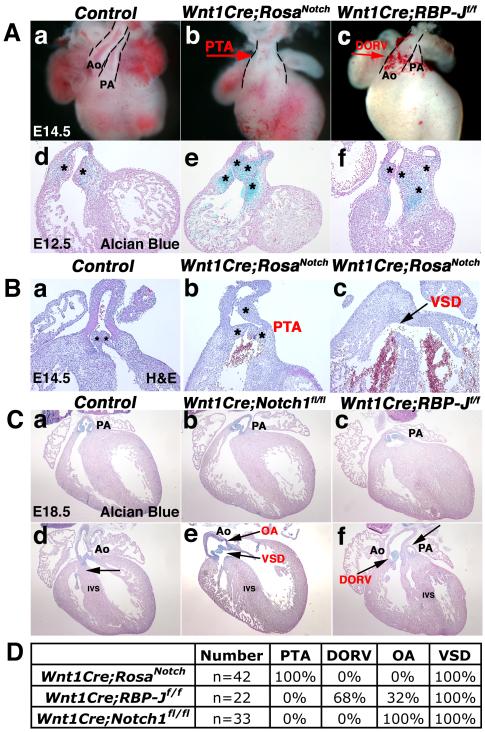Fig. 2.
Neural crest-specific gain or loss of Notch signaling results in cardiac outflow tract malformations. (A) Wnt1Cre;RosaNotch hearts exhibit defective cardiac OFT septation resulting in PTA (b, red arrow; e). DORV is apparent in Wnt1Cre;RBP-Jf/f hearts (c, red arrow; f) as compared to a wildtype control littermate (a,d). Endocardial cushions are stained with Alcian blue (d-f). (B) Wnt1Cre;RosaNotch hearts exhibit PTA and an accompanied VSD (black arrow) at E14.5 apparent in H&E stained sections as compared to a Wnt1Cre-negative RosaNotch control littermate (a-c). (C) Wnt1Cre;Notch1fl/fl hearts exhibit OA and VSD (e, black arrows), while Wnt1Cre;RBP-Jf/f heart sections exhibit DORV with pulmonary stenosis (f, black arrows), as compared to E18.5 control sections (a,d). The intact IVS is indicated by an arrow in d. Valve leaflets are stained with Alcian blue (a-f). (D) Wnt1Cre;RosaNotch mice exhibit 100% penetrance of PTA and VSD at E14.5. 100% of Wnt1Cre;RBP-Jf/f embryos have OFT malformations with the majority containing DORV and the minority exhibiting OA from E14.5 until birth. Wnt1Cre;Notch1fl/fl mice exhibit 100% OA from E14.5 until birth. Dashed lines outline OFT (A). * Denotes number of heart cushions in section plane (B). Ao, aortic root; PA, pulmonary artery root; PTA, persistent truncus arteriosus; DORV, double outlet right ventricle; VSD, ventricular septal defect; OA, overriding aorta; IVS, interventricular septum. (n=8 for each genotype at each age analyzed)

